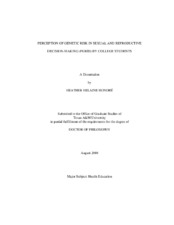| dc.description.abstract | One psychosocial variable, human mate selection, has been studied extensively
within the field of evolutionary psychology. A question of interest is how
sexual/reproductive decision-making (i.e., dating, marrying, and childbearing) might be
influenced by an individual’s perception of his/her genetic risk and other psychosocial
variables. There is a paucity of empirical studies within the literature exploring this
specific relationship.
This partially mixed, sequential mixed methods study addresses how individual
perception of genetic risk (PGR) influences or predicts sexual/reproductive intentions
and decision-making. A systematic review of the literature was conducted by searching
for English language, peer-reviewed, empirical studies in Cambridge Scientific Abstracts
databases (N=26). Next, students from three Southwestern universities were recruited
for focus groups and responded to 15 open-ended questions (N=86). Transcripts were
audiotaped, transcribed verbatim and analyzed using holistic-content analysis. Based on the literature review and qualitative findings, a 138-item, web-based instrument was
designed and tested at two Southwestern universities (N=2,576). Survey data were
analyzed using non-parametric univariate analyses and multiple regression.
Approximately 50 demographic, individual/familial psychosocial and genetic
testing-related factors influenced the relationship between PGR and sexual/reproductive
decision-making in reviewed studies. Individual psychosocial factors (e.g., intention,
attitudes) represented 65.8% of all findings. Participants in the qualitative phase
exhibited moderate health literacy when interpreting and discussing genetic risk
information. A number of factors including age, gender, religion, individual/family
values, and exposure to genetic concepts/technology appeared to influence
sexual/reproductive decision-making.
Demographic, Health Belief Model (HBM) and Theory of Planned Behavior
(TPB) variables predicted the relationship between PGR and dating, marital, and
childbearing intention in the quantitative phase. TPB variables were the strongest
predictors of intention accounting for 33.1-38.7% of variance. Positive family norms
were the single best predictor of dating and marital intention. Age was the best predictor
of childbearing intention.
Further research is needed to understand how young adults incorporate genetic
risk perceptions into sexual/reproductive decision-making. Mixed methods and
longitudinal study designs, and structural equation modeling are recommended for use in
future studies. Study findings affirm a need for health educators to consider adopting genomic competencies; creating theory-based curricula/interventions; and forming
partnerships with genetic specialists and local/regional health departments. | en |


